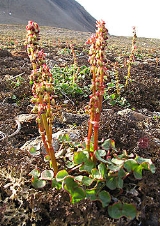
Oxyria digyna
Encyclopedia
Oxyria digyna a species of flowering plant in the buckwheat family
. It is common in the tundra
of Arctic
. Further south, it has a circumboreal distribution
, growing in high mountain
ous areas in the Northern Hemisphere like the Alps
, Sierra Nevada, and Cascade Range
.
It grows in dense tufts, with stems 10-20 cm high. Both flowering stems and leaf stalks are somewhat reddish. Leaves are kidney-shaped, somewhat fleshy, on stalks from the basal part of the stem. Flowers are small, green and later reddish, and are grouped in an open upright cluster. The fruit is a small nut, encircled by a broad wing which finally turns red. Forming dense, red tufts, the plant is easily recognized. O. digyna grows in wet places protected by snow in winter. Oxyria (from Greek
) means "sour".
, containing about 36 mg/100g. They were used by the Inuit
to prevent and cure scurvy
, and can be used in salads. It is called qunguliq in Inuktitut. The above-ground parts of the plant are edible when cooked http://www.northernbushcraft.com/plants/mountainSorrel/notes.htm.
Polygonaceae
Polygonaceae is a family of flowering plants known informally as the "knotweed family" or "smartweed family"— "buckwheat family" in the United States. The name is based on the genus Polygonum and was first used by Antoine Laurent de Jussieu in 1789 in his book, Genera Plantarum. The name refers...
. It is common in the tundra
Tundra
In physical geography, tundra is a biome where the tree growth is hindered by low temperatures and short growing seasons. The term tundra comes through Russian тундра from the Kildin Sami word tūndâr "uplands," "treeless mountain tract." There are three types of tundra: Arctic tundra, alpine...
of Arctic
Arctic
The Arctic is a region located at the northern-most part of the Earth. The Arctic consists of the Arctic Ocean and parts of Canada, Russia, Greenland, the United States, Norway, Sweden, Finland, and Iceland. The Arctic region consists of a vast, ice-covered ocean, surrounded by treeless permafrost...
. Further south, it has a circumboreal distribution
Circumboreal Region
The Circumboreal Region is a floristic region within the Holarctic Kingdom in Eurasia and North America, as delineated by such geobotanists as Josias Braun-Blanquet and Armen Takhtajan....
, growing in high mountain
Mountain
Image:Himalaya_annotated.jpg|thumb|right|The Himalayan mountain range with Mount Everestrect 58 14 160 49 Chomo Lonzorect 200 28 335 52 Makalurect 378 24 566 45 Mount Everestrect 188 581 920 656 Tibetan Plateaurect 250 406 340 427 Rong River...
ous areas in the Northern Hemisphere like the Alps
Alps
The Alps is one of the great mountain range systems of Europe, stretching from Austria and Slovenia in the east through Italy, Switzerland, Liechtenstein and Germany to France in the west....
, Sierra Nevada, and Cascade Range
Cascade Range
The Cascade Range is a major mountain range of western North America, extending from southern British Columbia through Washington and Oregon to Northern California. It includes both non-volcanic mountains, such as the North Cascades, and the notable volcanoes known as the High Cascades...
.
It grows in dense tufts, with stems 10-20 cm high. Both flowering stems and leaf stalks are somewhat reddish. Leaves are kidney-shaped, somewhat fleshy, on stalks from the basal part of the stem. Flowers are small, green and later reddish, and are grouped in an open upright cluster. The fruit is a small nut, encircled by a broad wing which finally turns red. Forming dense, red tufts, the plant is easily recognized. O. digyna grows in wet places protected by snow in winter. Oxyria (from Greek
Greek language
Greek is an independent branch of the Indo-European family of languages. Native to the southern Balkans, it has the longest documented history of any Indo-European language, spanning 34 centuries of written records. Its writing system has been the Greek alphabet for the majority of its history;...
) means "sour".
Uses
The leaves have a fresh acidic taste and are rich in vitamin CVitamin C
Vitamin C or L-ascorbic acid or L-ascorbate is an essential nutrient for humans and certain other animal species. In living organisms ascorbate acts as an antioxidant by protecting the body against oxidative stress...
, containing about 36 mg/100g. They were used by the Inuit
Inuit
The Inuit are a group of culturally similar indigenous peoples inhabiting the Arctic regions of Canada , Denmark , Russia and the United States . Inuit means “the people” in the Inuktitut language...
to prevent and cure scurvy
Scurvy
Scurvy is a disease resulting from a deficiency of vitamin C, which is required for the synthesis of collagen in humans. The chemical name for vitamin C, ascorbic acid, is derived from the Latin name of scurvy, scorbutus, which also provides the adjective scorbutic...
, and can be used in salads. It is called qunguliq in Inuktitut. The above-ground parts of the plant are edible when cooked http://www.northernbushcraft.com/plants/mountainSorrel/notes.htm.

